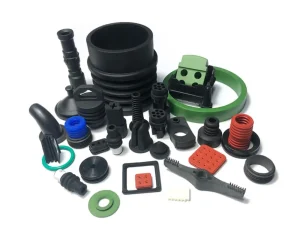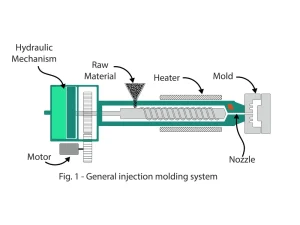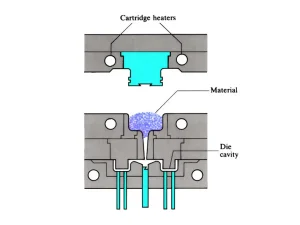Rubber products are commonly used in routine life. They are all the result of the rubber molding process. Interestingly, there are different types of rubber molding processes. Each of those varies in terms of how it produces the final products. Some of those types are suitable for creating bigger-sized products.
Similarly, some molding processes are inexpensive and ideal for making small products. People only know about rubber injection molding. It is the most popular method for creating rubber products. However, there are a few other types as well. We’ll discuss each of those types in detail. So, let’s get started!
Overview of Rubber Molding

The rubber molding process uses a mold to create rubber products. A mold is a hollow frame or container with specifically designed cavities. Mols are precisely similar to the parts that you need. Molten rubber is filled in these cavities of the mold. This molten material solidifies, adopts the shape of the mold, and makes a product.
This molding process is not new. It has been in use since the 19th century. However, it was not very advanced, and people had to do everything manually. For example, they did not have molding machines. So, they used to fill the mold manually, which took more time. Moreover, it was not safe, as more human efforts were involved.
Things have changed now as more advanced technologies are used in rubber molding. Moreover, different types of rubber are manufactured to get the desired results. Both synthetic and organic rubbers are used in these methods. Generally, organic rubbers are preferred due to their better recyclability.
The rubber molding process can create small or bigger-sized products. For example, you can get gaskets, seals, syringes, stoppers, and even vehicle tires. What makes this method stand out is its consistency. You can get hundreds of similar-shaped products in no time. They all will have the same shape and characteristics.
Types of Rubber Injection Process
Different methods are used in rubber molding. Each of those methods is unique in terms of how it uses the raw rubbers. Moreover, each of these methods uses molding machines. Let’s go down and discuss each process in detail.
1- Rubber Injection Molding

This is the most used one when it comes to creating rubber products. It uses rubber injection molding machines for its processing. The molten material is injected into the mold’s cavities with the help of an injection unit. The whole process happens through dedicated machines. Minimal human efforts are involved.
I’ve explained the complete rubber injection molding process in the previous article. Let’s have a brief overview. First, the granules of rubbers are added to the machines. These granules go into the barrels of the injection molding machines. There are heating elements around these barrels. Remember, these barrels contain a giant screw.
This screw rotates and forces the rubber granule against the wall of the barrels. The heating element present near the walls melts these granules. The injection unit then forces this molten rubber into the mold’s cavity. The cooling process happens in the mold cavity. As a result, the molten material solidifies.
Once the rubber becomes solid, it is ejected from the mold. This process takes some time, but it can make high-quality products. It also offers excellent repeatability, so you can use this method to create thousands of similarly shaped products. Both organic and non-organic rubber materials can be used in this method.
Pros and Cons Rubber Injection Molding
Pros:
- Low Material Waste
- Excellent Surface Finish
- High-Volume Production
- Complex Shape Capability
- High Precision and Consistency
Cons:
- Flashing Risk
- Material Limitations
- High Initial Tooling Cost
- Long Lead Time for New Molds
- Equipment Costs and Maintenance
2- Rubber Compression Molding
The rubber compression molding process is unique. It does not melt the material before being injected into the molds. Instead, it first fills the mold with rubber materials. Once done, pressure and heat are applied to melt and compress the material. The cooling process solidifies the material and makes a final product.
Let’s discuss this rubber molding process in more detail. First, manufacturers take part in rubber materials. This part size is similar to the size of the output product. Then, this cut part is filled inside the mold. Remember, the mold has two halves. Manufacturers fill the mold while keeping it open.
Once the whole material is filled, the mold is closed. Manufacturers apply pressure inside this mold to compress the rubber material. After that, heat is used to melt and soften the material filled inside the mold. This material becomes molten. The cooling process solidifies this molten rubber present inside the mold.
After solidification, you’ll get a final product. You might wonder how manufacturers apply force in the closed mold. Well, the mold consists of dedicated channels. These channels can carry pressurized air or hot water to do the job. For cooling, these channels can also hold cold water, which reduces the temperature of the mold.
Pros and Cons Rubber Compression Molding
Pros:
- Ideal for making larger products
- Works with a wide range of rubber materials
- Relatively inexpensive as compared to other rubber molding types
Cons:
- Less suitable for making small rubber products
- It does not offer excellent finishing to the products.
- This molding type takes more time to complete one cycle.
- Less precise as compared to the injection molding method
3- Rubber Transfer Molding

The rubber transfer molding type differs from injection and compression molding types. It relies on transferring rubber material from the pot to the mold. It does not compress or use injection units to inject the molten material into a mold. This method uses a separate container known as a pot.
This pot remains just above the mold. Moreover, it also has openings that allow material to go inside the mold. First, you’ll have to take the measured rubber material. This method ensures you use the rubber to make your final product. This results in very little waste on raw rubber material.
The rubber material is then placed on the pot. It is pressed with the plunger, and the rubber goes inside the mold. Remember, the mold is present just under the pot. The pot openings allow material to go straight into the mold, so there is no waste. Moreover, each cavity of the mold is equally filled.
Once the mold is filled, you’ll have to apply heat to this mold. As a result of heating, the rubber material will soften and melt. The cooling process solidifies this molten material and makes a final product. The ejection process is similar to all these rubber molding processes. People love this method as it does not waste any rubber material.
Pros and Cons Rubber Transfer Molding
Pros:
- Excellent precision
- It is ideal for creating small products such as rubber rings and seals.
- This method does not waste the rubber material while working. This is a significant advantage that makes it very popular.
Cons:
- Not suitable for creating bigger-sized products
- Require cleaning of pots after every cycle or use
- It is not ideal if you need a higher volume of products. Its longer cycle time is the only culprit.
How to Choose the Right Rubber Molding Process?
This is an important question, as each process impacts the output. The selection required is a critical analysis of all these methods. Remember, each product requires a different molding process. In the section below, I’ll discuss the key factors that will help you choose the right molding method for your products.
1- Design Complexity
The design of the product that you are making influences the selection process. The rubber molding process varies in terms of creating complex shapes. For example, injection molding is ideal for creating intricate designs. On the flip side, the rubber compression molding is compromised when creating intricate designs. I recommend going with rubber injection molding if your product has complex designs.
2- Production Cost
Rubber molding types vary in terms of pricing. For example, rubber compression molding is less expensive. It is the best solution if you need only a few products. On the flip side, injection and transfer molding are costly. They are only suitable if you need high-volume production. Analyzing the cost per production is crucial when choosing these molding methods.
3- Cycle Times
Cycle times refer to the time taken by completion of a batch of products. It includes the time required for filling molds, then heating and cooling. The injection molding machines are more advanced. So, they quickly complete the process and give output in no time. The rubber compression and transfer methods are relatively slow. They are suitable when you don’t need to meet any strict deadlines.
4- Prototype and Test
Many people don’t know about prototypes and end up making wrong decisions. The prototypes are the kind of samples that you get. For example, you need a specific rubber product. You can ask the manufacturer to prepare a prototype of your product. The manufacturer will create one product from each of these molding methods. You can carefully analyze the quality of each molding type product. This will help you better understand which method is best for you.
Veelgestelde vragen
What are the different types of rubber molding process?
There are three main types of rubber molding methods. Those include injection, compression, and transfer molding. Each of these rubber molding types offers a unique value proposition.
Which rubber molding types offer 100% precision?
The rubber injection molding type is excellent in terms of precision. It uses machines and does not require human involvement. You will need to provide the raw material in the form of granules. These machines handle all the work, including injecting molten material.
What is the rubber molding process?
Rubber molding is a manufacturing process that uses a mold to produce products. In this process, rubber undergoes heating. Its molten form is filled in the mold, and this molten material solidifies to form a product.
Which method should I choose: injection, compression, or transfer molding?
There is no one fit for all when it comes to the selection of the molding process. I recommend the injection molding process as it offers 100% precision. Moreover, it has a small cycle time, which is a big plus. However, you can choose compression molding if you have a tight budget.
Conclusie
Undoubtedly, rubber molding is handy in making rubber products. It comes with multiple perks that manufacturers love. In the past, this molding process had many limitations. However, things have changed now. Subtypes of rubber molding processes are available.
These methods make life easier by offering many unique features. I have discussed three main types of rubber molding processes in this article. You can choose any of them and get your product made. Hopefully, this article will end your search for the best type for you.

